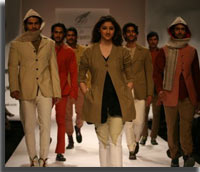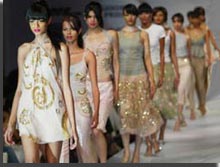| Size of the INDUSTRY | Net worth of Rs.1000 crore |
| Geographical distribution | All the major metropolitian cities like Mumbai, Delhi, Chennai, Banglore, Hyderabad, Pune. |
| Output per annum | According to approximations, the total market in India is calculated to be about Rs 20,000 crore. |
| Percentage in world market | Indian fashion industry accounts for barely 0.2 % of the international industry's net worth |

After the independence, Indian Fashion industry witnessed the effects of globalization. Due to this, changes occurred in the dressing style of Indians, which even led to the fusion of Indian and western dresses. Wearing kurtis on jeans, spaghetti with sarees are the examples showing the effect of western culture on Indian. The work of Indian designers is highly appreciated all over the world. Western brands are also coming to participate in Indian fashion weeks, as they see a lot of potential in our market.

In urban India, the women commonly wear salwar kameez and the churidar kameez, is worn by women who go to work and the saree is worn on formal occasions. Men wear kurtas and pajamas, or a sherwani for formal wear. Western wear such as shirts and trousers are commonly worn by men across India. Jeans, T-shirts, capris, bermudas are the kind of casual clothing worn by the young and the young at heart, who are the trendsetters of fashion in India.
Since the last decade the Indian fashion industry has moved from the embryonic stage to a blossoming take-off. Fashion designers have contributed immensely to the spread of fashion as a driving force, both among Indian consumers and select segments of Western markets. India can now boast of dozens of leading fashion designers, who can match any European fashion designer in their concepts, styles and designs. Ritu Beri, Rohit Bal, Ritu Kumar, Abraham and Thakore, Deepika Govind, Gitanjali Kashyap, Indira Broker, J.J.Valaya, Lina Tipnis, Manoviraj Khosla, Pavan Aswani, Payal Jain, Ravi Bajaj, Rina Dhaka, Sharon Leong and Chandrajit Adhikari, Shaina NC, Sonali and Himanshu, Wendell Rodricks, Anna Singh, Ashish Soni, Jatin Kochar, Madhu Jain, Manish Malhotra, Ravi Bajaj, Salim Asgarally and Tarun Tahlliani top the growing list of reputed fashion designers in India.
According to approximations, the total market in India is calculated to be about Rs 20,000 crore. The branded Fashion market's size is nearly one fourth of this or Rs 5,000 crore. Designer wear, in turn, covers nearly about 0.2 % of the branded apparel market. Today the largest sales turnover within the designer wear segment is about Rs 25 crore, with other well-known names having less turnovers of Rs10-15 crore.
As per the estimates, Indian designer wear commands a category engagement of 66 % for male customers and 57 % for female customers. The category engagement in western designer wear is 5%. The per capita per annum on designer wear for men amounts up to Rs 48,627 and Rs 56,271 for women.
The proliferation of fashion-based programmers on the satellite television channels has increased the consciousness of the average Indian masses about the changing trends in the global fashion. This industry is also generating a lot of business and becoming a booming industry for generating a lot of jobs for people. More and more fashion training institutes and fashion corporations are cropping up. Many national and international brands are establishing themselves in Indian market. The mall culture has immensely helped in the growth of our fashion industry. Thus, globalization has completely changed the face of our Indian fashion industry.
- The organized market for designer apparel is about Rs 250 crore and designer wear calculates to less than 1 % of the apparel market. The global market for designer wear is 5 % of total apparel market and the global market for designer wear industry is largely dependent on the small-scale sector. Consumers for designer wear have a yearly household income of Rs 10 lakh-plus. There are 3 lakh such households developing at 40-45 %. Designer wear industry is projected to increase to Rs 1,000 crore by 2015. More than 81 % of the population below 45 years of the age is fashion conscious
- Today the fashion designers and management experts foresee an average growth of about 10-12 % for the Indian fashion industry in the coming years.
- Though, the growth rate could be more than 15%, if infrastructural and other logistical bottlenecks and drawbacks are over come, Indian fashion design industry is expected to grow much faster than projected (Rs. 500 cr.) and likely to touch Rs.750 cr. by 2012 from the current level of Rs.270 cr. because Indian companies are heavily investing big sums in the industry, consumers are increasingly shifting focus towards designer wear, exposure to western media and readily available of designer wear in the shopping malls, according to The Associated Chambers of Commerce and Industry (ASSOCHAM).
 Recent Press Release
Recent Press Release
 INDIAN fashion Industry AT A Glance IN 2019 - 2020
INDIAN fashion Industry AT A Glance IN 2019 - 2020
 INDIAN fashion Industry AT A Glance IN 2018 - 2019
INDIAN fashion Industry AT A Glance IN 2018 - 2019
 INDIAN fashion Industry AT A Glance IN 2017 - 2018
INDIAN fashion Industry AT A Glance IN 2017 - 2018
 INDIAN fashion Industry AT A Glance IN 2016 - 2017
INDIAN fashion Industry AT A Glance IN 2016 - 2017
 INDIAN fashion Industry AT A Glance IN 2015 - 2016
INDIAN fashion Industry AT A Glance IN 2015 - 2016
 INDIAN fashion Industry AT A Glance IN 2014 - 2015
INDIAN fashion Industry AT A Glance IN 2014 - 2015
 INDIAN fashion Industry AT A Glance IN 2013 - 2014
INDIAN fashion Industry AT A Glance IN 2013 - 2014
 INDIAN fashion Industry AT A Glance IN 2012 - 2013
INDIAN fashion Industry AT A Glance IN 2012 - 2013
 INDIAN fashion Industry AT A Glance IN 2011 - 2012
INDIAN fashion Industry AT A Glance IN 2011 - 2012
Indian Industries


